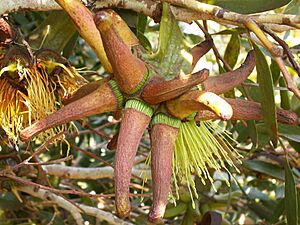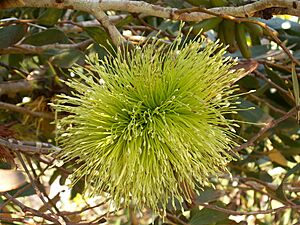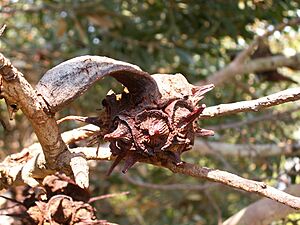Bushy yate facts for kids
Quick facts for kids Bushy yate |
|
|---|---|
 |
|
| Eucalyptus lehmanni near Ravensthorpe | |
| Scientific classification | |
| Genus: |
Eucalyptus
|
| Species: |
lehmannii
|
The Bushy Yate (scientific name: Eucalyptus lehmannii) is a special type of eucalypt tree. It belongs to the Myrtaceae family, which also includes plants like myrtle. This tree is found only in the southwest part of Western Australia. It's a small tree that spreads out and has lots of leaves, sometimes reaching the ground.
People grow it a lot in Australia and the United States because it looks beautiful with its unique shape, pretty flowers, buds, and fruits. Sometimes, it can be a bit confusing to classify because it can mix with other types of eucalypts.
Contents
What Does Bushy Yate Look Like?
The Bushy Yate is often a mallee, which means it has many stems growing from the ground. Its bark is smooth and can be whitish-grey, grey-brown, or orange-brown. It peels off in strips.
Young Plants
When the plant is young, its stems are triangular. The leaves are usually oblong or oval-shaped, about 5 to 8 cm long and 1 to 3 cm wide. They are shiny green on top and dull blue-green underneath.
Adult Leaves and Flowers
Older stems are smooth and round. The adult leaves are oval-shaped, about 4.5 to 9.5 cm long and 0.7 to 2.8 cm wide. Both sides are glossy light to mid-green. Like all eucalypts, these leaves have oil glands, but they are hard to see.
The flowers grow in clusters where the leaves meet the stem. They have a flattened stalk that curves downwards as the flowers open. Each cluster can have 11 to 19 or more buds. These buds are quite long, about 3.3 to 6.5 cm, including their cap. The stamens (the parts that produce pollen) are green-yellow and stand upright.
How Did Bushy Yate Get Its Name?
The Bushy Yate was first named in 1844 by a scientist named Johannes Conrad Schauer. He called it Symphyomyrtus lehmannii. Later, in 1867, another scientist named George Bentham moved it to the Eucalyptus group and officially named it Eucalyptus lehmannii.
The tree was named after Johann Georg Christian Lehmann. He was a Professor of Botany and the Director of the Botanic Gardens in Hamburg, Germany. He also edited the book where the plant was first described.
Similar Species
There has been some confusion between E. lehmannii and another species called E. conferruminata. Some experts think they are the same tree. Others tell them apart by looking at the length of the cap on the flower bud. E. conferruminata is said to have a shorter cap.
Where Does Bushy Yate Grow?
The Bushy Yate is found in the southern coastal and near-coastal areas of Western Australia. You can see it from east of Albany all the way to Israelite Bay. It also grows in the Stirling Range.
It likes sandy soils, often over granite or quartzite rock, and sometimes with gravel on rocky hills and coastal sand dunes. It grows in several different natural areas of Western Australia, including the Esperance Plains, Jarrah Forest, Mallee, and Warren regions.
Is Bushy Yate Invasive?
Sometimes, a plant can grow so well in a new place that it spreads too much and takes over. This is called being "invasive." Eucalyptus lehmannii, along with some other eucalypt types like Eucalyptus cladocalyx, Eucalyptus globulus, and Eucalyptus grandis, has been described as invasive in parts of southern Africa. This means they can outcompete native plants there.
What Is Bushy Yate Used For?
The Bushy Yate is a popular plant for gardens and landscaping in Australia. It can be used to create a small screen, planted alone as a beautiful feature tree, or grown in a group.
It's also grown in other countries, including Europe and South Africa. In the United States, it's known as a good tree for creating a screen or as an attractive tree for courtyards, even in cooler areas like the San Francisco Bay.




